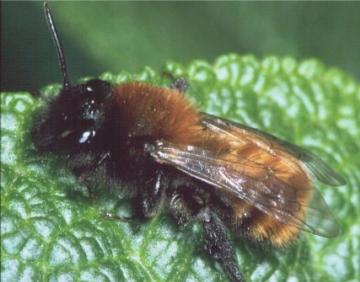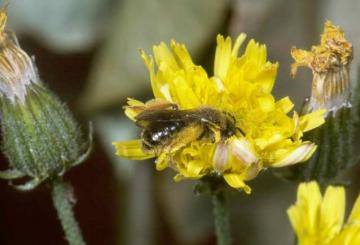Bees wasps and ants survey
Help bees in your garden and look out for the Tawny mining bee
Records of aculeate Hymenoptera (bees, wasps and ants) in Essex are maintained by the County Recorder Peter Harvey.
Gardens can offer good habitat for a number of insects and spiders. Important features to promote include a range of nectar and pollen resources suitable for different species and a range of relatively undisturbed corners in the garden where some dead wood, leaf litter and dead stems can be left. Try not to be too tidy! Earth banks, fences and walls with old mortar in the sun are also important nesting habitat for bees and wasps. Various insects and spiders will also use them to warm up early in the year and in the early morning.
The Tawny mining bee Andrena fulva is a solitary bee that is an important pollinator of fruit trees in spring. If you want a good crop, hope this bee visits your garden! The female is very characteristic in appearance. Note the orange-brown hairs over the thorax and abdomen and black hairs on the face legs and sides. This is a widespread bee, but it is very under-recorded in Essex. I would welcome records of the species with at least details of date and location. Submit records
If you can bear to leave a few €˜weeds to grow and flower in the garden, then you can do even better. Red Dead-nettle, Black Horehound and yellow composites (Asteraceae) such as Crepis grow in my garden and have resulted in some exceptional occurrences. Since I live within the metapopulation range of some East Thames Corridor specialities, I get a few rarities in my small garden, some occasional but also several regular visitors. I have seen the national Biodiversity Action Plan bumblebee Bombus humilis foraging at runner bean flowers, and the Nationally Scarce mining bees Andrena fulvago and the black Andrena pilipes are regular visitors foraging on Crepis and Hebe flowers respectively.
Only six bumblebees remain widespread in Britain, and these are nowadays often more abundant in gardens than in the modern countryside. They can successfully use flowers as nectar and pollen resources in gardens, and are far more important as pollinators of fruit trees and many other flowers than honeybees. However even these common bumblebees tend to collect pollen from a rather restricted range of plants, and you can help them by providing the right kind of flower resources. As well as fruit trees in spring and early summer such as Malus (apples), Prunus (cherries, plums, greengage) and Ribes (currants), any flowers in the pea and labiate families are good, and some useful plants to grow include Ajuga, Betonica officinalis, Erica, Eryngium, Buddleia, Knautia, Lathyrus, Lythrum, Salvia, Stachys, Teucrium, etc. Make sure they are single varieties, not double.
Help the insects to help you!




















